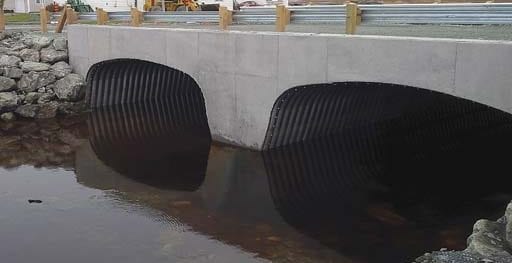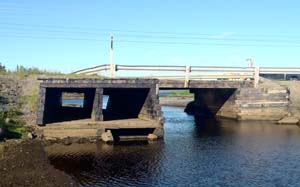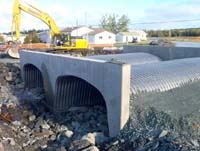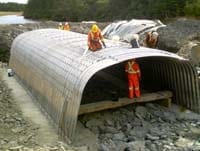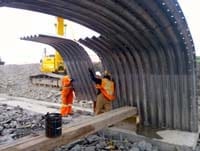When the Newfoundland & Labrador Department of Transportation & Works needed to replace the failed Main Point timber bridge in Gander Bay, AIL’s engineering team worked with the DOT’s Senior Bridge Engineer to come up with a suitable solution for this tidal application.
First Box Culverts in NL to use a pile foundation
The preferred option would have been a single 12 m (39.4′) span of corrosion/abrasion-resistant Dur-A-Span Structural Aluminum Plate but, to eliminate the need for reinforcement ribs, the AIL engineering team recommended twin 6.1 m (20′) box culverts instead. However, due to poor clay-like foundation conditions, it was determined that settlement limits were exceeded and pile foundations were required.
VIDEO: Take a 360° video tour of this project >>
Because the new bridge was in the same location as the old one, both a traffic diversion and a river diversion had to be created. Then excavation could begin for the pile footing areas, which were driven into bedrock at a depth of about 9 m (30′).
Forms were placed over top of the piles and the reinforced concrete footings with aluminum base channels were poured. With the aluminum structures now physically tied into the site’s bedrock, they offer the ultimate solution for this storm-prone, saltwater environment.
In addition to on-site assistance during construction, AIL helped the DOT during the design stage by preparing a detailed scope of work to help the contractors make competitive bids and keep the project on budget.
Over 75 years of design service life
Lightweight, strong and easy to install, Dur-A-Span is a corrosion/abrasion-resistant solid aluminum alloy structural plate that can provide over 75 years of design service life in saltwater and aggressive soils. Spans can reach up to 12.2 m (40′) with AIL’s latest innovations in reinforcement rib technology.



